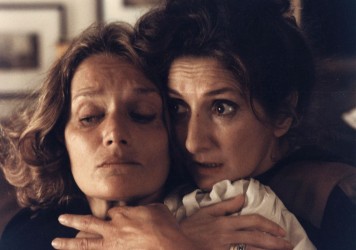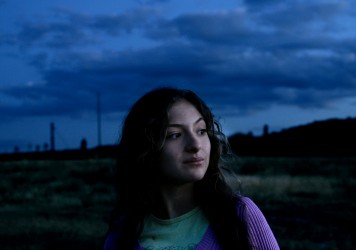
With Hermia & Helena, Matías Piñeiro delivers another refreshingly modern twist on The Bard.
Through his previous three films, Rosalinda, Viola and The Princess of France, Argentina’s Matías Piñeiro has established himself as one of the most inventive and exciting translators of Shakespeare to the screen. Frequently compared to the likes of Eric Rohmer and Jacques Rivette, his talkative, reality-bending, effervescently postmodern adaptations freely deconstruct, reimagine and transpose The Bard’s texts to the present day without any of the pretentiousness or alienating intellectualism that customarily accompany such exercises.
The three films mentioned above each follow an expansive trajectory, opening up thematically as they distance themselves from their source texts (‘As You Like It’, ‘Twelfth Night’ and ‘Love’s Labour’s Lost’ respectively). Piñeiro’s latest, Hermia & Helena, which premiered at this year’s Locarno Film Festival, continues this trend, though the jump is significantly greater this time around. The film takes its inspiration from ‘A Midsummer Night’s Dream’, and the protagonists are still bohemian twentysomethings, they’re still for the most part girls, and they’re still played by Piñeiro’s loyal and preternaturally ageless troupe of actors.
The most immediately obvious departure is the relocation to New York City. Piñeiro’s previous films were set in Buenos Aires, but in his Shakespeare adaptations the specificity of the location was purposely de-emphasised. Apart from its opening, Rosalinda was entirely set in an idyllic and semi-fantastic countryside that functioned as theatrical stage-cum-societal microcosm. Both Viola and The Princess of France used urban settings, but to foreground the characters’ emotional journeys the cityscape was kept largely anonymous, an impression reinforced by DP Fernando Lockett’s intimate camera.
In Hermia & Helena, however, the location is crucial, and this is signalled from the start. Following an opening montage of flowers and cherry blossoms – both a nod to Japanese actress Setsuko Hara, to whom the film is dedicated, and to Piñeiro’s favoured focus, the ephemerality of life – the story begins with a virtuosic shot from atop a building reminiscent of both the opening of The Princess of France and of Coppola’s The Conversation. The camera covertly tracks a character as he walks through Columbus Park before soaring back up to frame distant skyscrapers jutting out from the city’s skyline. New York will assume the role of the forest from ‘A Midsummer Night’s Dream’, a place where Piñeiro’s heroine, Camila (Augustina Muñoz), loses herself in a whirl of romantic confusion and opportunity having travelled alone from Buenos Aires on a fellowship to translate the play into English.
This tactic of physically situating Shakespeare’s text within the film is familiar from Hermia & Helena’s predecessors, but otherwise, this is Piñeiro’s loosest adaptation to date. Rosalinda is the only one of his films to draw the majority of its scenes directly from its corresponding play, with characters rehearsing segments from all acts in roughly chronological order. Viola lifts a single scene from Shakespeare, whereas The Princess of France borrows the ending from ‘Love’s Labour’s Lost’ as its starting point and explores its potential consequences in a contemporary scenario that reimagines the titular princess as three different women. There are no such direct narrative parallels in Hermia & Helena and, also unlike the others, the film doesn’t include any scenes of rehearsals, which Piñeiro had previously used to experiment with the lyrical possibilities of modulating Shakespeare’s lines through repetition.
It’s a pity that these scenes are absent, as they represent an innovative way of getting around the tricky feat of integrating Shakespeare’s prose into a present-day setting, as well as a forceful demonstration of their lasting transporting power. Piñeiro acknowledges the omission of these signature scenes through a hilarious moment in which Camila gives Spanish lessons and her pupil reads her translated verses aloud in broken, tuneless Spanish. It’s only in Camila’s imagination that the verses appear in their intended form, whispered to herself in voice-over and goading her romantic fantasies, as when the inversion expressed in the lines “Apollo flies, and Daphne holds the chase; the dove pursues the griffin; the mild hind makes speed to catch the tiger” kindles unexpected desire for another girl.
Along with the rehearsals, another characteristic that has all but disappeared is the balletic camerawork, although this absence isn’t as keenly felt. Going for a more distanced aesthetic, Lockett and his co-cinematographer Tommy Davis (who subbed in for the few days Lockett was unavailable) largely forego the formerly predominant shallow focus and frequently use long shots, which had almost never featured in Piñeiro’s other films, generating an effective and narratively consequential dynamic between character and setting. Landscapes also play a prominent role for the first time, gorgeously captured to engender potent yet unobtrusive pathetic fallacies.
The film’s more grounded visual style reflects Piñeiro’s thematic progression. His work has often received comparison to the French New Wave because of his buoyant portraits of youthful love and infidelity. Though still strongly ironic, the end of The Princess of France presents the first intimation of the genuine emotional pain that can and, as youthfulness dissipates, increasingly does accompany promiscuity. This dimension is further elaborated in Hermia & Helena and Camila’s trip upstate to meet her father Horace (the first “adult” in Piñeiro’s Shakespearean universe, played by the indie director Dan Sallitt), whom she has never met, brings into sharp perspective her own numerous dalliances throughout the film. This duality is implied by the film’s title, as Camila comes to incorporate both the courted Hermia and the anguished Helena, and Piñeiro injects her portrait with a hitherto unfamiliar but deeply affecting note of pathos. Are Piñeiro’s forever young finally growing up?
Published 8 Aug 2016

Themes of social displacement and isolation will be explored in the documentary series ‘Frames of Representation’.

By Tom Graham
Thirty years after its original release, The Official Story remains a vital account of the country’s military dictatorship.

By Matt Turner
Documentary filmmakers Betzabé García and Tatiana Huezo are giving a voice to victims of violent abuse.